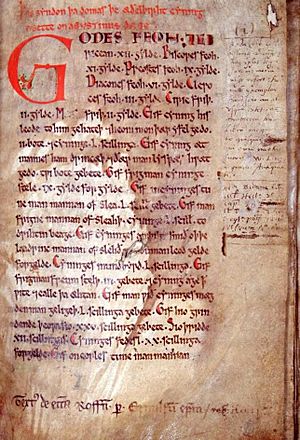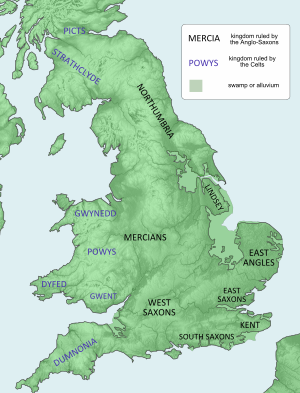Wihtred of Kent facts for kids
Quick facts for kids Wihtred |
|
|---|---|
| King of Kent | |
| Reign | c. 690 – 23 April 725 |
| Born | c. 670 |
| Died | 23 April 725 (aged 54–55) |
| Issue | Æthelberht II, Eadberht I, and Alric |
| Father | Ecgberht |
Wihtred (born around 670 – died April 23, 725) was a king of Kent. He ruled from about 690 or 691 until his death. Wihtred was the son of Ecgberht I and the brother of Eadric.
He became king after a difficult time in the 680s. During this period, Kent was briefly taken over by Cædwalla of Wessex. There were also many fights among different royal families. Wihtred's rule brought peace and order back to Kent. Soon after becoming king, he created a set of laws called the Law of Wihtred. These laws are still preserved in an old book called the Textus Roffensis. Wihtred's laws focused a lot on the rights of the Church. They also set punishments for things like unusual marriages and worshipping old pagan gods. Wihtred ruled for a long time, and not many major events were recorded during his reign. When he died in 725, his sons, Æthelberht II, Eadberht I, and Alric, took over the kingdom.
Contents
Kent in the Late 600s: A Time of Change
In the late 600s, a powerful king named Wulfhere of Mercia controlled much of southern England. He ruled from the 650s to 675. During much of this time, Ecgberht was the king of Kent. Ecgberht died in 673. His sons, Eadric and Wihtred, were very young when their father passed away. Wulfhere was their uncle because he was married to Eormenhild, Ecgberht's sister.
Ecgberht's brother, Hlothhere, became king of Kent in 674. It's possible that Wulfhere did not want Hlothhere to become king. Wulfhere might have been the real ruler of Kent for about a year before Hlothhere took the throne.
Kent's Troubles and New Rulers
Eadric, Wihtred's brother, later started a fight against his uncle Hlothhere. Hlothhere died from battle wounds in February 685 or 686. Eadric himself died the next year. According to Bede, a famous historian, the kingdom of Kent fell into chaos.
In 686, Cædwalla of Wessex invaded Kent. He made his brother Mul king there. When Mul was killed in 687, Cædwalla might have ruled Kent directly for a while. When Cædwalla left for Rome in 688, Oswine became king. Oswine was likely supported by Æthelred of Mercia.
Oswine lost power in 690. However, Swæfheard, the son of King Sebbi of Essex, had also been a king in Kent for a year or two. Records show that both Swæfheard and Oswine were kings at the same time. It seems Oswine ruled eastern Kent, which was usually the main part of the kingdom. Swæfheard likely ruled western Kent.
Wihtred Becomes King of Kent
Wihtred brought order back to Kent and became king in the early 690s. Bede, the historian, said Wihtred was the "rightful" king. He also said Wihtred "freed the nation from foreign invasion" with his hard work. Oswine was also from the royal family and had a claim to the throne. So, Bede's words might show support for Wihtred from the Church.
Two old documents help us figure out when Wihtred became king. One document from April 697 says he was in his sixth year of rule. This means he became king between April 691 and April 692. Another document from July 17, 694, is from his fourth year as king. This suggests he started ruling between July 690 and July 691. Putting these together, it seems Wihtred likely became king between April and July 691. Bede also said Wihtred ruled for 34 and a half years. Since he died on April 23, 725, this would mean he became king in late 690.
Wihtred's Rule and Family
At first, Wihtred ruled alongside Swæfheard. In July 692, when Beorhtwald became Archbishop of Canterbury, both Swæfheard and Wihtred were mentioned as kings of Kent. But Swæfheard is not mentioned after this date. By 694, Wihtred seemed to be the only ruler of Kent. It's also possible his son Æthelberht was a junior king in western Kent during his father's reign.
Wihtred is thought to have had three wives. His first wife was Cynegyth. However, a document from 696 names Æthelburh as his queen. This means his first wife must have died or been divorced. Near the end of his rule, a new wife, Wærburh, is mentioned with Wihtred and their son, Alric.
In 694, Wihtred made peace with King Ine of the West Saxons. Ine's brother, Mul, had been killed by the people of Kent. Wihtred agreed to pay a large amount of money as compensation for Mul's death. Most old records say "thirty thousand," possibly meaning thirty thousand pounds. This amount was equal to a king's wergild, which was the legal value of a person's life. It's also likely that Wihtred gave some land near the border to Ine as part of this agreement.
The Laws of Wihtred

The oldest Anglo-Saxon law code we have is from Æthelberht of Kent, who ruled until 616. Later, in the 670s or 680s, a law code was issued by Hlothhere and Eadric of Kent. After them, King Ine of Wessex and King Wihtred also created laws.
Historians believe Wihtred's laws were issued on September 6, 695. Ine's laws were written in 694 or just before. Ine and Wihtred had recently made peace, and it seems they worked together on their laws. One rule appears almost exactly the same in both law codes. Also, Wihtred's laws use the West Saxon word gesith for a noble, instead of the Kentish word eorlcund. This suggests they cooperated. It's possible that Ine and Wihtred issued these laws to show their power and bring order after difficult times in their kingdoms.
What Wihtred's Laws Covered
Wihtred's laws were issued at a place called "Berghamstyde," which might be Bearsted near Maidstone. These laws mainly focused on religious matters. Only four of the twenty-eight chapters are not about Church affairs. The first rule of the code said the Church was free from taxes.
Other rules set punishments for:
- Unusual marriages
- Worshipping pagan gods
- Working on Sundays
- Not following fasting rules
The laws also explained how people from different parts of society could prove their innocence by taking an oath. This included the king, bishops, priests, common people (called ceorls), and servants (called esnes). The introduction to the laws clearly shows how important the Church was in making these rules. The Archbishop of Canterbury, Bertwald, and the Bishop of Rochester, Gefmund, were both present. The Church leaders and the people of Kent all agreed on the laws.
The Church received special rights:
- Freedom from taxes.
- A bishop's oath was as strong as the king's oath.
- The Church received the same compensation as the king if harm was done to its followers.
This shows that the Church was very powerful in Kent, almost as powerful as the king. However, the laws also included punishments for people who "sacrifice to devils." This means that even though Christianity was strong, some people still followed older pagan beliefs.
Clause 21 of the laws said that a common person (a ceorl) needed three people from his own class to be his "oath-helpers." An oath-helper would swear an oath to help clear an accused person. Ine's laws were stricter, requiring a high-ranking person to be an oath-helper for everyone. These laws together suggest that the old system, where a man's family was legally responsible for him, was becoming weaker.
Wihtred's Death and Who Ruled Next
When Wihtred died, he left the kingdom of Kent to his three sons: Æthelberht II, Eadberht I, and Alric. It's not completely clear how their reigns followed each other. However, we know that both an Æthelbert and at least one Eadbert ruled in the years after Wihtred. After Wihtred's death, and King Ine of Wessex leaving for Rome the next year, Æthelbald of Mercia became the most powerful ruler in southern England.
See also



